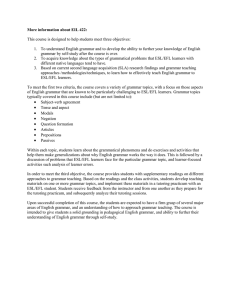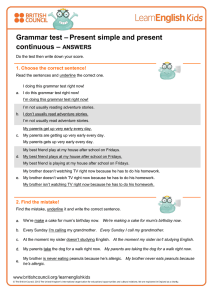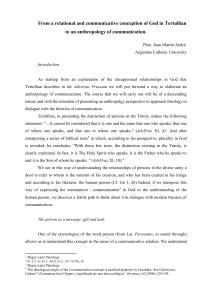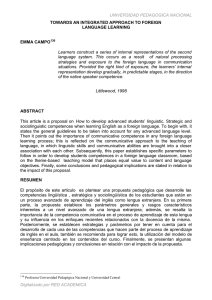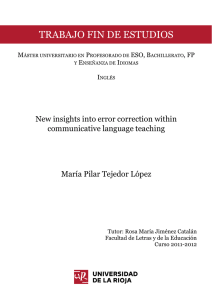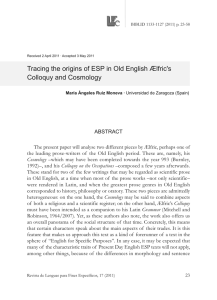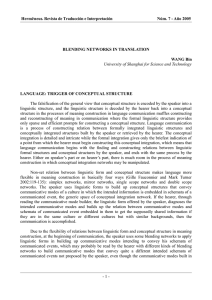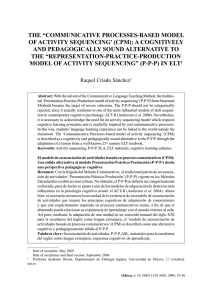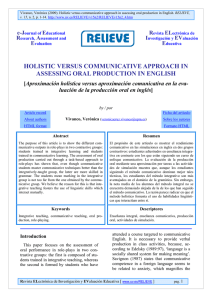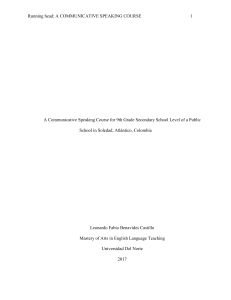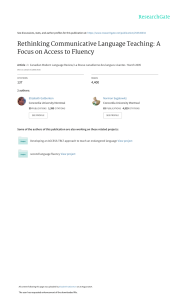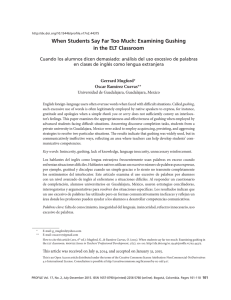Teaching the Communicative Use of ESP in Text
Anuncio
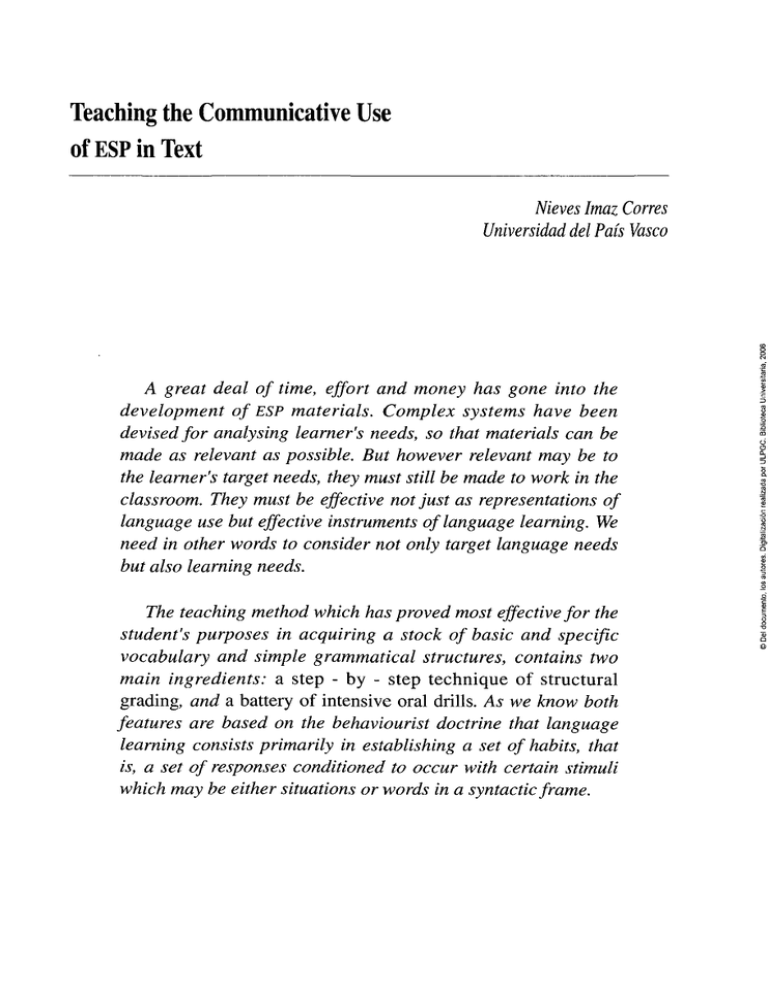
Teaching the Communicative Use ofESPinText Nieves Imaz Corres Universidad del País Vasco A great deal of time, ejfort and money has gone into the development of ESP materials. Complex systems have been devised for analysing leamer's needs, so that materials can be made as relevant as possible. But however relevant may be to the leamer's target needs, they must still be made to work in the classroom. They must be effective notjust as representations of language use but effective instruments oflanguage learning. We need in other words to consider not only target language needs but also learning needs. The teaching method which has proved most effective for the student's purposes in acquiring a stock of basic and specific vocabulary and simple grammatical structures, contains two main ingredients: a step - by - step technique of structural grading, and a battery of intensive oral drills. As we know both features are based on the behaviourist doctrine that language learning consists primarily in establishing a set of habits, that is, a set of responses conditioned to occur with certain stimuli which may he either situations or words in a syntactic frame. 1. Introduction In recent years, English Language Teaching overseas has taken on a new character. Previously, it was usual to talk about the aims of English leaming in terms of the so-called four 'language skills' and these aims were seen as relating to general education at the primary and secondary levéis. Recently, however, a need has arisen to specify the aims of English learning more precisely as the language has increasingly been required to take on an auxiliary role at the tertiary level of education. English teaching has been called upon to provide students with the basic ability to use the language to receive, and (to a lesser degree), to convey Information associated with their specialist studies. This is particularly so in the developing countries where essential textbook material is not available in the vernacular languages. The purpose of this paper is to suggest that what is needed is a different orientation to English study and to outhne an approach which departs from that which is generally taken. Broadly, what is involved is a shift of the focus of attention from the grammatical to the communicative properties of the language. I take the view that the difficulties which the student encounters arise not so much from a defective knowledge of the system of English but from an unfamiliarity with English use and so their needs cannot be met by a course which simply provides further practice in the composition of sentences but Revista de lenguas para fines específicos N - 2 (1995) 193 Nieves Imaz Corres only by one which develops a knowledge of how sentences are used in the performance of different communicative acts. The approach which I Hke to outiine here, then, represents an attempt to move from an almost exclusive concern with grammatical forms to at least an equal concern with rhetorical functions. 2. The use of Language in Text In considering the formal properties of language in use, we must first decide on what attitude to adopt to the teaching of grammar. What factors do we have to take into consideration in designing a model of grammar for advanced or remedial language teaching? We may assume firstly that a pedagogic granmiar for advanced learners must provide the student with fresh and stimulating material. There is no point in presenting a remedial English class at the University level with a speedy-up versión of the secondary school syllabus, for the class will rapidly become bored and resentful. It must be stressed that the task for the advanced learner is not simply to experience more language material but to develop a complex set of organisational skills over and above those which he needed to cope with the elementary syllabus, and to leam to put these to use in serving a variety of communicative purposes. Students at advanced levéis have had a good deal of instruction in grammar and are likely to possess considerable dormant competence in English. It follows that one of the principal aims of advanced language teaching should be to actívate this competence and to extend it, by leading the student to relate his previously-acquired linguistic knowledge to meaningful realisations of the language system in passages of immediate relevance to his professional interests or specialised field of studies. A second consideration is that the Information in a pedagogic grammar must be relevant to a learner's need. In order to ensure this we must insist on a clear distinction between linguistic and pedagogic grammars. A linguistic grammar is concerned with a specification of the formal properties of a language, while the purpose of a pedagogic grammar is to help a learner acquire a practical mastery of a language. 194 Revista de lenguas para fines específicos N - 2 (1995) Teaching the Communicative Use ofESP in Text There is no reason for supposing that the two types of statement will bear any overt resemblance to one another. It is particularly important that this principie should be clearly stated at a time when many teachers and textbook writers are tuming to linguistics as a source of ideas about how to handle language in the classroom. In general, I expect that a knowledge of linguistic grammars will provide teachers with pedagogically useful insights into language structure but we do not expect that the content of a linguistic grammar will be reflected in any direct or systematic way in a pedagogic grammar based on it. A further principie is that pedagogic grammars are typically eclectic. By this we mean that the applied linguist must pick and choose among formal statements in the light of his experience as a teacher, and decide what are pedagogically the most appropriate ways of arranging the Information that he derives from linguistic grammars. Thus, we expect that the insights incorporated in a pedagogic grammar will be drawn from a number of hnguistic models, and that the teaching materials will be judged solely in terms of whether or not they promote quick and efficient leaming in the student. We assume that the students have some knowledge about how the language works which derives from pedagogic grammar. We also assume that this knowledge will be Consolidated as they experience language used in meaningful contexts. For these reasons we have not attempted to provide a detailed review of English grammar. Instead, the grammar exercises are designed to focus on points which are particularly important in scientific writing, especially those which may represent continuing "trouble spots" for many students. Wherever possible we aim to avoid the more mechanical types of substitution drill. The whole approach we adopt in this paper is based on the assumption that the students will be people whose minds are directed towards rational thought and problemsolving, and the grammar exercises are designed to take this fact into account. Wherever possible, we have here, as elsewhere, used exercises which we hope will require the same kind of thinking that science students would naturally be engaged in as part of their specialist studies. The Revista de lenguas para fines específicos N - 2 (1995) 195 Nieves Imaz Corres foUowing examples show how we have attempted to provide grammar practice in a meaningful way, and without losing sight of the natural communicative use of language. EXERCISE A: Definitions in Scientific Discourse a) A is/ate B Which C may be defined as eg. A thermometer is an instrument which is used for measuring temperaturas. A thermometer may be defined as an instrument which is used for measuring temperatures. b) B Which C is/are called A is/are known as eg. An instrument which is used for measuring temperatures is called a thermometer. An instrument which is used for measuring temperatures is known as a thermometer. Expand the following into fuU definitions. Write each sentence twice, using any of the pattems illustrated above. 1.- Metamorphosis / the physical transformation / is undergone by various animáis during development after the embryonic state. 2.- Metals / the class of chemical elements / are characterised by ductility, malleability, lustre and conductivity. EXERCISE B: Formation ofthe Impersonal Passive Write down the passive versión of all the active sentences. Then combine the passive sentences, following the clues provided in the box. Active: we may show the expansión of gas Passive: the expansión of a gas Active: we heat the gas Passive: the gas Active: we demónstrate an apparatus in Figure 41 Passive: an apparatus in Figure 41 196 Revista de lenguas para fines específicos N - 2 (1995) Teaching the Communicative Use ofESP in Text The expansión of a gas when it apparatus in Figure 41. may by the EXERCISE C: Time Expressions Rewrite the sentences, selecting one of the time expressions and putting it at the beginning of the sentence. The time expression you select should be the one which corresponds most closely to the meaning of the words in italics, which should be omitted. 1.- The water vapour condenses to as a result it is able to fall downwards as rain or snow (when, before). 2.- The aluminium is in the measuring cylinder during this time we may measure the volume of water displaced (as soon as, while). 3.- First the water is forced out of the ballast tanks by compressed air before this the submarine is not able to rise to the surface (until, when). Compare the following sentences with your answer in Part (i). If the sentences have approximately the same meaning, put a tick in the box; if not, put a cross. 1.- Water vapour can fall as rain or snow but the vapour must condense to water first. 2.- A volume of water is displaced and as a result we can put the aluminium in the measuring cylinder. 3.- A submarine is not able to rise to the surface while the ballast tanks are fuU of water. 3. Conclusión It may seem to some extent that exercises based on a surface structure approach constitute a return to outmoded principies. There is an important issue at stake here, which we touched on earlier in our discussion of the Revista de lenguas para fines específicos N - 2 (1995) 197 Nieves Imaz Corres distinction between linguistic and pedagogic grammars. A number of recent publications have shown a tendency to assume that the latest developments in linguistic theory should at all costs be reflected in language teaching materials. But it is not always the latest linguistic model which provides the most satisfactory basis for the preparation of teaching materials. For example, the relevant treatment of transformations for our purpose appears to be that of Zellig Harris rather than Chomsky. For Harris, transformational analysis is a logical extensión of constituent analysis, and is based on the same criteria of form and distribution. Transformations are set up formally as a relation between text sentences, and not in the form of instructions of generating sentences, as in Chomsky's theory. A pedagogically useful consequence is that we can distinguish wellestablished transformations from those which are barely acceptable or used only in particular linguistic environments. Moreover, Harris's transformational rules are relevant to the notion of communicative competence, and therefore seem to be a more suitable basis for teaching material than Chomsky's transformations, which opérate without reference to context. BIBLIOGRAPHY Glendinning, Eric H. 1987. English in Mechanical Engineering. Oxford: Oxford University Press. Houp & Pearsall. 1992. Reporting Technical Information. Maxwell Macmillan International. Anne A. Pañares. A Handbook of English for Technical Students. Maxwell Macmillan International. 198 Revista de lenguas para fines específicos N°2 (1995)
